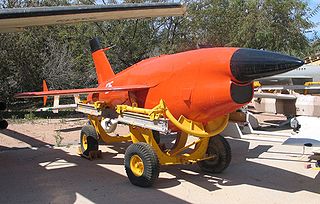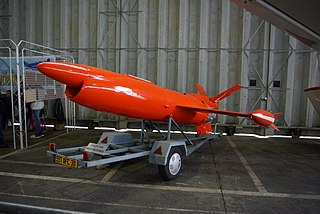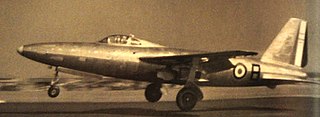
The Fuji T-1 Hatsutaka was Japan's first jet-powered trainer aircraft. Its first flight was in January 1958. A total of 66 T-1 planes were built. It was retired in March 2006.

The Miles M.77 Sparrowjet was a twin-engined jet-powered racing aircraft built by the British aircraft manufacturer F.G. Miles Limited. It was a one-off conversion, involving the fitting of Turbomeca Palas turbojet engines to the prototype Miles Sparrowhawk, enabling the aircraft to achieve higher performance than could be achieved with its conventional piston engine arrangement.

The Fouga CM.170 Magister is a 1950s French two-seat jet trainer aircraft that was developed and manufactured by French aircraft manufacturer Établissements Fouga & Cie. Easily recognizable by its V-tail, almost 1,000 have been built in France and under licence in West Germany, Israel, and Finland.

The Armstrong Siddeley Viper is a British turbojet engine developed and produced by Armstrong Siddeley and then by its successor companies Bristol Siddeley and Rolls-Royce Limited. It entered service in 1953 and remained in use with the Royal Air Force, powering its Dominie T1 navigation training aircraft until January 2011.

The Temco TT Pinto is a tandem two-seat primary jet trainer built for the United States Navy by Temco Aircraft of Dallas, Texas.

The Ryan Firebee is a series of target drones developed by the Ryan Aeronautical Company beginning in 1951. It was one of the first jet-propelled drones, and remains one of the most widely used target drones ever built.

The Morane-Saulnier MS.760 Paris is a French four-seat jet trainer and liaison aircraft designed and manufactured by Morane-Saulnier.

The Turbomeca Marboré is a small turbojet engine that was produced by Turbomeca from the 1950s into the 1970s. The most popular uses of this engine were in the Fouga CM.170 Magister and the Morane-Saulnier MS.760 Paris. It was also licensed for production in the United States as the Teledyne CAE J69. In Spain the Turbomeca model Marboré II was manufactured by ENMASA under license with the name Marboré M21.
The Fouga CM.88 Gemeaux was a 1950s French engine test-bed aircraft produced by Fouga. An unusual aircraft, it was two aircraft joined by a common wing.

The Hispano HA-200 Saeta is a twin-seat jet advanced trainer designed and produced by Spanish aircraft manufacturer Hispano Aviación. It has the distinction of being the first Spanish aircraft to harness jet propulsion.

The Ikarus 451 is a family of research aircraft designs built in Yugoslavia in the 1950s, all sharing the same basic airframe, but differing in powerplants and cockpit arrangements. One member of the family Ikarus 451M became the first domestically-built jet aircraft to fly in Yugoslavia, on 25 October 1952.

The Leduc 022 was the prototype of a mixed-power French interceptor built in the mid-1950s. Designer René Leduc had been developing ramjet-powered aircraft since before World War II and had flown a series of experimental aircraft, the Leduc 0.10 and Leduc 0.21, throughout the 1950s before he was awarded a contract for two examples of a short-range supersonic interceptor armed with two air-to-air missiles (AAMs).

The Teledyne CAE J69 was a small turbojet engine originally produced by Continental Aviation and Engineering (CAE) under license from Turbomeca. The J69 was a development of the Turbomeca Marboré II. It powered a number of U.S. drones, missiles and small aircraft. The engine was later produced by Teledyne CAE. The J69 was also developed into the Teledyne CAE J100 turbojet optimized for operation at higher altitudes.

The Morane-Saulnier MS.755 Fleuret was a prototype French two-seat jet trainer designed and built by Morane-Saulnier. It failed to gain any orders but was developed into the larger four-seat MS.760 Paris.

The SNCASO SO.9000 Trident is a French jet and rocket powered interceptor aircraft built by aircraft manufacturer SNCASO during the 1950s. As part of a wider effort to re-build French military power during the late 1940s and to furnish France with advanced, new domestically produced designs, a request for a supersonic-capable point-defence interceptor aircraft to equip the French Air Force was issued to SNCASO. In response, the firm designed the mixed-propulsion Trident, powered by a single SEPR rocket engine, which was augmented by wingtip-mounted turbojet engines, and the Air Force ordered two prototypes.

The Nord Aviation CT20 was a French turbojet-powered radio-controlled target drone introduced in 1957. Developed from the Arsenal / S.F.E.C.M.A.S. T.5.510, the CT.20 was built by Nord Aviation and powered by a Turbomeca Marboré II engine, providing a top speed of 900 km/h and a flying time of 55 to 60 minutes. It has been noted for its similarity to the Ryan Firebee. The unmanned drone was used in the development of air-to-air missiles following the Second World War.
The SIPA S.300 was a French turbojet powered basic trainer, claimed to be the first of its kind anywhere. Only one was built, the prototype crashing after a year's development.
The Procaer Cobra was a two-seat turbojet powered light aircraft designed and built in Italy and flown in the early 1960s. Only one was completed.

The Sud-Ouest SO.6020 Espadon (Swordfish) was a French post-war prototype interceptor designed and built by SNCASO during the late 1940s. The French Air Force judged the design a failure despite some records being set and cancelled plans to put it into service in 1951. Only four aircraft were built and they were later modified to serve as testbeds for the mixed rocket and turbojet-powered SNCASO SO.9000 Trident program. Only one badly damaged aircraft survives.
The Hurel-Dubois Miles HDM.105 was a transport aircraft fitted with very high aspect ratio wings for research purposes, building on research carried out with the Hurel-Dubois HD.10, and a stepping point to the planned production HDM.106 Caravan. The HDM.105/HDM.106 provided the starting point for the design of the Short SC.7 Skyvan.

















